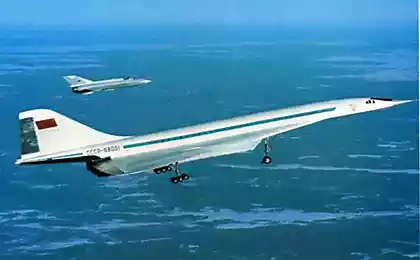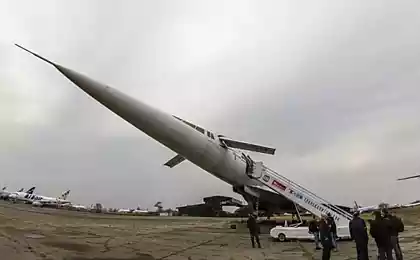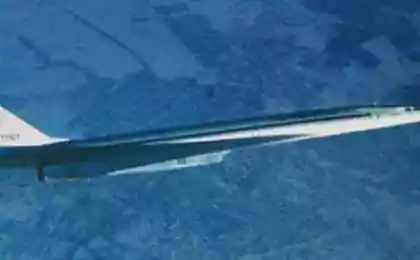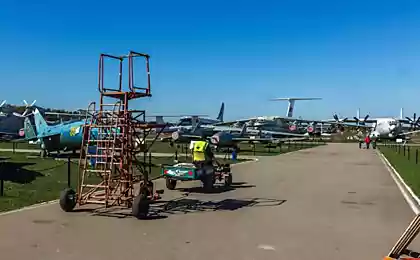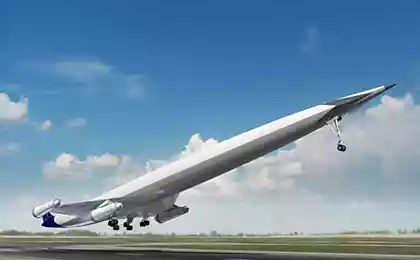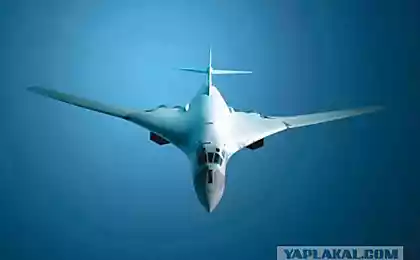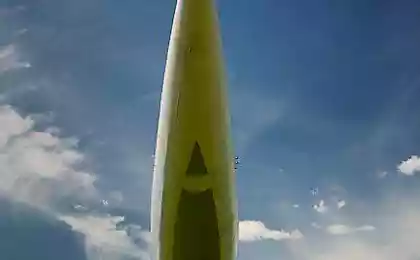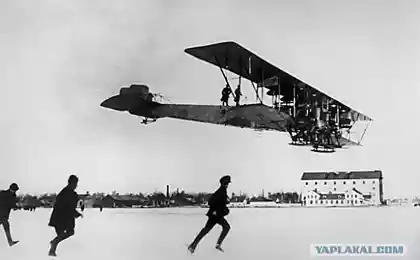847
TU-144 that was left
A bit of information taken from Wikipedia, and 12, almost all of my pictures in the made air museum in the city of Ulyanovsk.
Tu-144 - Soviet supersonic passenger aircraft developed by the Tupolev Design Bureau in the 1960s and commercially produced at an aircraft factory VASO in Voronezh. In addition to the Concorde, the Tu-144 is the first of two supersonic airliners ever used airlines for commercial passenger transport.
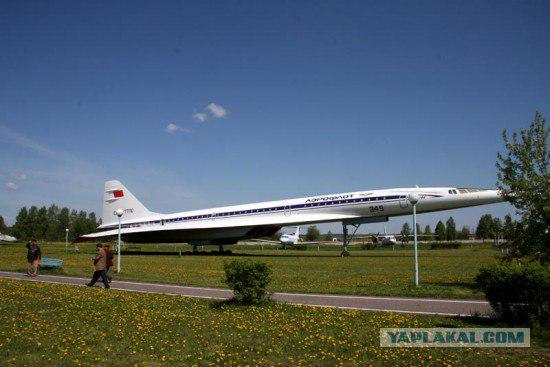
Despite the fact that the Tu-144 is less known than his "partner" Concord, the first flight of the Tu-144 took place on December 31, 1968, that is two months before the Concorde. Tu-144 is also the first in the history of passenger airliner, flew at supersonic speed, it happened (June 5, 1969) at an altitude of 11,000 meters. Next symbolic milestone in the Mach 2 aircraft overcame the May 25, 1970, flying at an altitude of 16,300 m at a speed of 2150 km / h. The aircraft joined together a huge number of advanced development and design solutions. For example, retractable on the flight canards (PGO), which can reduce the speed at landing. Tu-144 can sit down and take off at 18 airports in the Soviet Union, while the Concorde, whose runway speed was 15% higher, for each airport required a separate certificate for landing. According to some experts, if the engines were located in Concord as well as the Tu-144, the crash July 25, 2000 would not have happened. The opinion expressed by one of the Soviet pilots who participated in the testing and operating the flights on Tu-144. According to him, back in the mid 70s during takeoff from the airport in Berlin with his plane took exactly the same case as with the victims "Concord": taking off from under the wheels of a sharp metal object struck the wing skin and the kerosene tank. The plane began to lose fuel. However, due to the fact that the engines on the Tu-144 is not separated on the wing, as the "Concord", and are concentrated at the fuselage flowing kerosene did not get into the stream of hot gases and fire arose. Airliner flying over an hour and landed safely on the territory of the Soviet Union. Thus, the scheme of the Tu-144 was better insured against such incidents than the "Concord».
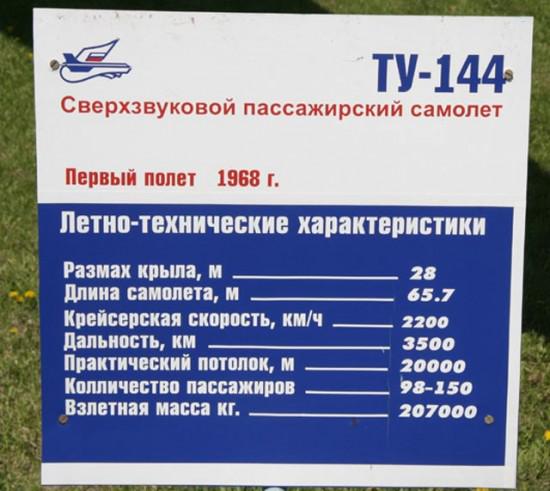
The main problem, determined the fate of the Tu-144 has low resistance to fatigue airframe panels, which are made by a process of machining thick plates of aluminum alloy.

Third June 1973 Tu-144 number 77102 crashed during a demonstration flight at Le Bourget. All six crew members (Hero of the Soviet Union, honored test pilot M. Kozlov, test pilot VM Molchanov, navigator GN Bazhenov, deputy chief designer, engineer, Major General V. Bender, a leading Engineer BA Pervukhin and flight engineer AI Dralin) died. The exact causes of the accident are still unknown, but the basic version is considered too sharp maneuver that the crew had to make in order to avoid a collision with a surprise appearance by the French "Mirage" (task pilot was to photograph the Soviet Tu-144 in flight), the violation of a control system, or else nerasschitanost airframe structures on the maneuver that the crew attempted to commit.
According to another version, which confirms the shot before leaving the aircraft at air show story for newsreels, airline pilot unit was installed equipment of automatic control, which has not been turned off. Control this system were to close the lid and seal, while on the remote crash site was found open and without seals. It is believed that the pilots turned on the system to improve the performance of maneuverability by improving the efficiency rudders. This was supposed to inflate the characteristics of the aircraft before speaking earlier in the day a competitor - Concord.

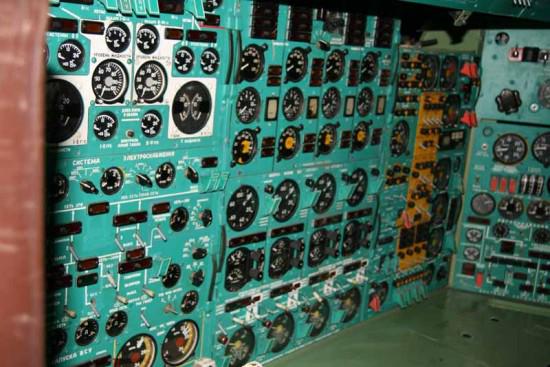
However, the Tu-144 began regular flights. The first working trip was committed December 26, 1975 on route from Moscow to Alma-Ata, where the plane perevёz mail and parcels, and since November 1977, in the same direction and began passenger service. Flights performed only two aircraft - № 77109 and № 77110. The pilots of "Aeroflot" only flew as a second pilot, the crew commanders have always been test-pilots Tupolev. A plane ticket cost 68 rubles [2], whereas in a conventional subsonic plane ticket to Alma-Ata was worth 48 rubles.
Commercial careers Tu-144 was short-lived.
According to the pilots, emergency situations have occurred in almost every flight. May 23, 1978 was second crash of the Tu-144. Superior prototype version of the plane, the Tu-144 (№ 77111) after the ignition of fuel in the area of the nacelle third power unit of the destruction of the fuel, smoke in the cockpit and off the crew of the two engines made an emergency landing in a field near the village of Ilyinsky, not far from the city Egoryevsk.
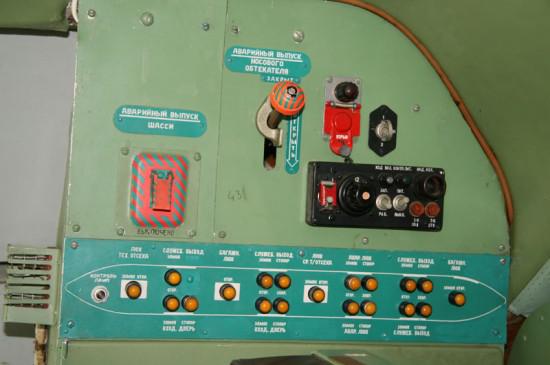
After landing, through the window of the crew left the plane cabin crew commander V. Popov, EV copilot and navigator Yelyan VV Vyazigin. Engineers are inside the VM Kuleshov, VA Isaev, VN Stolpovsky left the plane through the front door. Flight engineers OA Nikolaev and VL Venediktov be trapped in the workplace deformed when planting designs and died. (Referring to the first ground, the nose cone swerved and went into the fuselage.) June 1, 1978 "Aeroflot" permanently ceased supersonic passenger flights.
Subsequently, the Tu-144 was used only for freight traffic between Moscow and Khabarovsk. In total, the Tu-144 makes 102 flights under the flag of "Aeroflot", 55 - passenger (transported 3194 passengers).
Series production aircraft were deployed at the Voronezh aircraft factory number 64

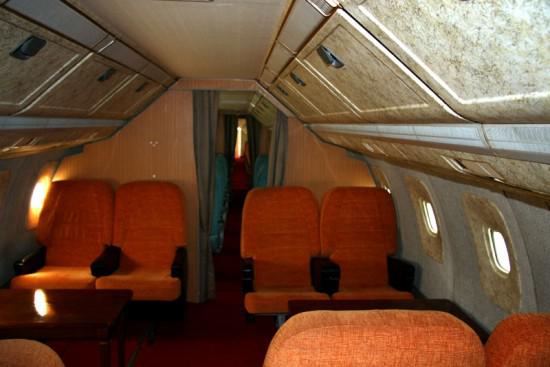
Later, the Tu-144 made only a few test flights and flights with a view to establishing world records. From 1995 to 1999, a significantly modified Tu-144 (number 77114) under the name Tu-144LL ("Flying Laboratory") was used by the American space agency NASA for research in the field of high-speed commercial flights with the aim to develop a plan to create a new, modern supersonic passenger aircraft . At the Tu-144LL was installed engines NK-32 due to a lack of usable NK-144 or RD-36-51, similar to those used on the Tu-160, a variety of sensors and test control and recording equipment.
There were built 16, Tu-144, which made a total of 2556 sorties and flown 4110 hours (among them the most, 432 hours flown aboard 77144). The construction of four more aircraft have not been completed.
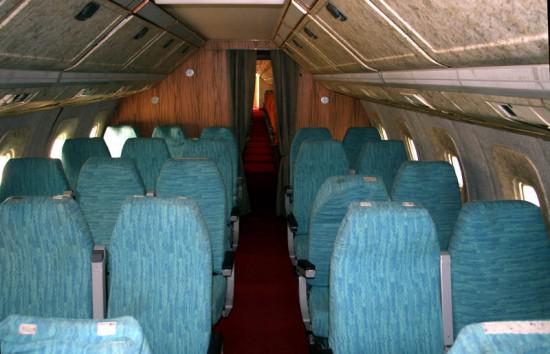
Prototypes and modifications
Build and converted:
Tu-144 ("044") - the first prototype number 68001 c the engine NK-144. It is very different in many elements of the design (the shape and profile of the wing, placing engines and landing gear, the design of the landing gear, the length and shape of the individual elements of the fuselage, ejection seats crew shoot the hatches to exit ejection seats and other features) from the pre-production and production and represented more just a single aircraft model.
Tu-144 ("004") - a pre-production prototype number 77101 c the engine NK-144.
Tu-144C - Serial (experienced and exploited) planes c engines NK-144A.
Tu-144 - c experimental production aircraft engines RD-36-51.
Tu-144LL - prototype Tu-144 c the engine NK-32.
Disadvantages aircraft
The high cost of production and operation.
Increased noise.
Not economical, high fuel consumption.

Destiny aircraft
The eternal monument of Tu-144 in Sinsheim, Germany (№ - 77,112) were built 16 machines - board 68001, 77101, 77102, 77103, 77105, 77106, 77107, 77108, 77109, 77110, 77111, 77112, 77113, 77114, 77115 and 77144.

Lёtnom remains in state does not currently exist. Almost fully staffed parts and can be restored to flight personnel state boards Tu-144LL number 77 114 and TU-144 № 77115.
In a recoverable state
Tu-144 №RA-77114 in ZhukovskomTU-144LL number 77,114, which was used for the tests by NASA, is stored at the airfield in Zhukovsky.
Tu-144 number 77115 is also stored at the airfield in Zhukovsky. In 2007, the Tu-144 number 77115 was re-painted in accordance with the historical color scheme and exposed for all to see at MAKS-2007.
Aircraft number 77114 and number 77115 are likely to be installed as a monument or on display at the airfield in Zhukovsky. In 2004-2005. to them were committed by some of the sale of scrap metal, but the protests aviation community did not give this to happen, though the risk of such an outcome is not completely eliminated. Questions about in whose property they will move, not completely resolved.
The museums
Tu-144 number 77106 to the Air Force Museum in Monino near Moscow.
Tu-144 number 77110 in the Museum of Civil Aviation in Ulyanovsk.
TU-144D number 77,112 in a museum in Sinsheim (Germany) is the most qualitatively restored instance. Installed next to the French "Concorde".
In keeping
Tu-144 number 77107 is stored in the Kazan Aviation Institute.
Tu-144 number 77108 is stored in the museum of Samara Aerospace University. [4]
Unpreserved planes
Tu-144 number 77102 crashed June 3, 1973 during a demonstration flight at Le Bourget (save the video).
Tu-144 number 77111 because of the fire in the air made an emergency landing near Egoryevsk (the aircraft was completely destroyed, killing 2 people)
The remaining aircraft were dismantled or cut non-ferrous metals in the 90s.
Source:
Tu-144 - Soviet supersonic passenger aircraft developed by the Tupolev Design Bureau in the 1960s and commercially produced at an aircraft factory VASO in Voronezh. In addition to the Concorde, the Tu-144 is the first of two supersonic airliners ever used airlines for commercial passenger transport.

Despite the fact that the Tu-144 is less known than his "partner" Concord, the first flight of the Tu-144 took place on December 31, 1968, that is two months before the Concorde. Tu-144 is also the first in the history of passenger airliner, flew at supersonic speed, it happened (June 5, 1969) at an altitude of 11,000 meters. Next symbolic milestone in the Mach 2 aircraft overcame the May 25, 1970, flying at an altitude of 16,300 m at a speed of 2150 km / h. The aircraft joined together a huge number of advanced development and design solutions. For example, retractable on the flight canards (PGO), which can reduce the speed at landing. Tu-144 can sit down and take off at 18 airports in the Soviet Union, while the Concorde, whose runway speed was 15% higher, for each airport required a separate certificate for landing. According to some experts, if the engines were located in Concord as well as the Tu-144, the crash July 25, 2000 would not have happened. The opinion expressed by one of the Soviet pilots who participated in the testing and operating the flights on Tu-144. According to him, back in the mid 70s during takeoff from the airport in Berlin with his plane took exactly the same case as with the victims "Concord": taking off from under the wheels of a sharp metal object struck the wing skin and the kerosene tank. The plane began to lose fuel. However, due to the fact that the engines on the Tu-144 is not separated on the wing, as the "Concord", and are concentrated at the fuselage flowing kerosene did not get into the stream of hot gases and fire arose. Airliner flying over an hour and landed safely on the territory of the Soviet Union. Thus, the scheme of the Tu-144 was better insured against such incidents than the "Concord».

The main problem, determined the fate of the Tu-144 has low resistance to fatigue airframe panels, which are made by a process of machining thick plates of aluminum alloy.

Third June 1973 Tu-144 number 77102 crashed during a demonstration flight at Le Bourget. All six crew members (Hero of the Soviet Union, honored test pilot M. Kozlov, test pilot VM Molchanov, navigator GN Bazhenov, deputy chief designer, engineer, Major General V. Bender, a leading Engineer BA Pervukhin and flight engineer AI Dralin) died. The exact causes of the accident are still unknown, but the basic version is considered too sharp maneuver that the crew had to make in order to avoid a collision with a surprise appearance by the French "Mirage" (task pilot was to photograph the Soviet Tu-144 in flight), the violation of a control system, or else nerasschitanost airframe structures on the maneuver that the crew attempted to commit.
According to another version, which confirms the shot before leaving the aircraft at air show story for newsreels, airline pilot unit was installed equipment of automatic control, which has not been turned off. Control this system were to close the lid and seal, while on the remote crash site was found open and without seals. It is believed that the pilots turned on the system to improve the performance of maneuverability by improving the efficiency rudders. This was supposed to inflate the characteristics of the aircraft before speaking earlier in the day a competitor - Concord.


However, the Tu-144 began regular flights. The first working trip was committed December 26, 1975 on route from Moscow to Alma-Ata, where the plane perevёz mail and parcels, and since November 1977, in the same direction and began passenger service. Flights performed only two aircraft - № 77109 and № 77110. The pilots of "Aeroflot" only flew as a second pilot, the crew commanders have always been test-pilots Tupolev. A plane ticket cost 68 rubles [2], whereas in a conventional subsonic plane ticket to Alma-Ata was worth 48 rubles.
Commercial careers Tu-144 was short-lived.
According to the pilots, emergency situations have occurred in almost every flight. May 23, 1978 was second crash of the Tu-144. Superior prototype version of the plane, the Tu-144 (№ 77111) after the ignition of fuel in the area of the nacelle third power unit of the destruction of the fuel, smoke in the cockpit and off the crew of the two engines made an emergency landing in a field near the village of Ilyinsky, not far from the city Egoryevsk.

After landing, through the window of the crew left the plane cabin crew commander V. Popov, EV copilot and navigator Yelyan VV Vyazigin. Engineers are inside the VM Kuleshov, VA Isaev, VN Stolpovsky left the plane through the front door. Flight engineers OA Nikolaev and VL Venediktov be trapped in the workplace deformed when planting designs and died. (Referring to the first ground, the nose cone swerved and went into the fuselage.) June 1, 1978 "Aeroflot" permanently ceased supersonic passenger flights.
Subsequently, the Tu-144 was used only for freight traffic between Moscow and Khabarovsk. In total, the Tu-144 makes 102 flights under the flag of "Aeroflot", 55 - passenger (transported 3194 passengers).
Series production aircraft were deployed at the Voronezh aircraft factory number 64


Later, the Tu-144 made only a few test flights and flights with a view to establishing world records. From 1995 to 1999, a significantly modified Tu-144 (number 77114) under the name Tu-144LL ("Flying Laboratory") was used by the American space agency NASA for research in the field of high-speed commercial flights with the aim to develop a plan to create a new, modern supersonic passenger aircraft . At the Tu-144LL was installed engines NK-32 due to a lack of usable NK-144 or RD-36-51, similar to those used on the Tu-160, a variety of sensors and test control and recording equipment.
There were built 16, Tu-144, which made a total of 2556 sorties and flown 4110 hours (among them the most, 432 hours flown aboard 77144). The construction of four more aircraft have not been completed.

Prototypes and modifications
Build and converted:
Tu-144 ("044") - the first prototype number 68001 c the engine NK-144. It is very different in many elements of the design (the shape and profile of the wing, placing engines and landing gear, the design of the landing gear, the length and shape of the individual elements of the fuselage, ejection seats crew shoot the hatches to exit ejection seats and other features) from the pre-production and production and represented more just a single aircraft model.
Tu-144 ("004") - a pre-production prototype number 77101 c the engine NK-144.
Tu-144C - Serial (experienced and exploited) planes c engines NK-144A.
Tu-144 - c experimental production aircraft engines RD-36-51.
Tu-144LL - prototype Tu-144 c the engine NK-32.
Disadvantages aircraft
The high cost of production and operation.
Increased noise.
Not economical, high fuel consumption.

Destiny aircraft
The eternal monument of Tu-144 in Sinsheim, Germany (№ - 77,112) were built 16 machines - board 68001, 77101, 77102, 77103, 77105, 77106, 77107, 77108, 77109, 77110, 77111, 77112, 77113, 77114, 77115 and 77144.

Lёtnom remains in state does not currently exist. Almost fully staffed parts and can be restored to flight personnel state boards Tu-144LL number 77 114 and TU-144 № 77115.
In a recoverable state
Tu-144 №RA-77114 in ZhukovskomTU-144LL number 77,114, which was used for the tests by NASA, is stored at the airfield in Zhukovsky.
Tu-144 number 77115 is also stored at the airfield in Zhukovsky. In 2007, the Tu-144 number 77115 was re-painted in accordance with the historical color scheme and exposed for all to see at MAKS-2007.
Aircraft number 77114 and number 77115 are likely to be installed as a monument or on display at the airfield in Zhukovsky. In 2004-2005. to them were committed by some of the sale of scrap metal, but the protests aviation community did not give this to happen, though the risk of such an outcome is not completely eliminated. Questions about in whose property they will move, not completely resolved.
The museums
Tu-144 number 77106 to the Air Force Museum in Monino near Moscow.
Tu-144 number 77110 in the Museum of Civil Aviation in Ulyanovsk.
TU-144D number 77,112 in a museum in Sinsheim (Germany) is the most qualitatively restored instance. Installed next to the French "Concorde".
In keeping
Tu-144 number 77107 is stored in the Kazan Aviation Institute.
Tu-144 number 77108 is stored in the museum of Samara Aerospace University. [4]
Unpreserved planes
Tu-144 number 77102 crashed June 3, 1973 during a demonstration flight at Le Bourget (save the video).
Tu-144 number 77111 because of the fire in the air made an emergency landing near Egoryevsk (the aircraft was completely destroyed, killing 2 people)
The remaining aircraft were dismantled or cut non-ferrous metals in the 90s.
Source:
